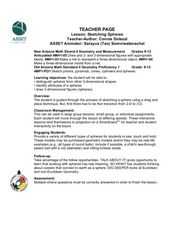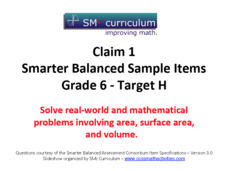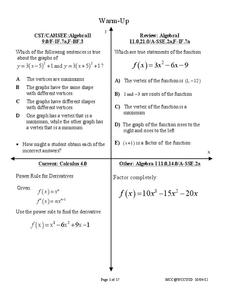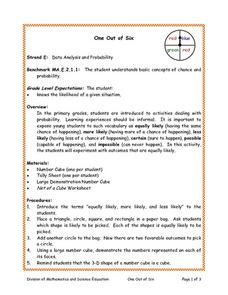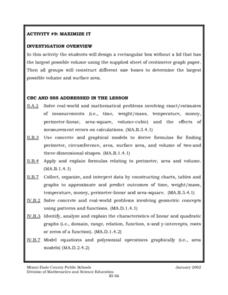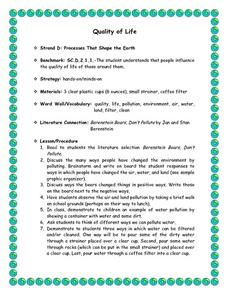Curated OER
Cones, Cylinders, Spheres
Students classify polygons by name and shape. In this geometry instructional activity, students identify the lateral surface of each conic. They differentiate between cones, cylinders and spheres.
Curated OER
Characteristics of Polygons
Fourth graders discuss characteristics of polygons and organize and visualize those characteristics using Kidspiration. Students import pictures that demonstrate the characteristics and save their projects to be reviewed and graded by...
Curated OER
Sketching Spheres
Students investigate spheres through sketches. In this geometry lesson, students sketch two and three dimensional shapes creating nets. They find and differentiate between the nets for prisms, pyramids, cones, cylinders and spheres.
Curated OER
Basic Design Elements Computer Art Project
Students use PhotoDraw software to create original drawings. Using the basic design elements, line, shape, form, texture, value, and color, students create original drawings on the computer based on drawings previously rendered by hand.
CCSS Math Activities
Smarter Balanced Sample Items: 6th Grade Math – Target H
Knowing the surface area certainly helps when deciding how much paint to buy before a project. Scholars solve for surface area, as well as volume and area, as part of the presentation from Grade 6 Claim 1 Item Slide Shows. Geometric...
Curated OER
Silly Science
For this science worksheet, learners use the dichotomous key to identify common objects listed on the sheet. Then they write the scientific name of each object.
Curated OER
Doin' The Moonwalk
If you are looking for an outstanding lesson on the Moon for your budding astronomers, look no further! This outstanding plan is full of wonderful, meaningful activities for your charges to engage in. Pupils will discover why there are...
Mr. Hill's Science Website
Density Workbook
It's all about density! Here's a dense workbook for young scientists; they solve (and show work for) 29 density word problems, including a problem where they solve for the density of Godzilla. They complete labs analyzing metal cubes,...
West Contra Costa Unified School District
Particle Motion
Derivatives are useful for many things — they can even keep track of particle motion. An informative lesson plan provides an introduction to the idea of the second derivative in particle motion. Class members determine the velocity...
Center for Civic Education
What Does Returning to Fundamental Principles Mean?
Looking for materials for your Constitution Day and Citizenship Day lessons? Then check out this packet of activities that not only gets your class members thinking critically about the fundamental principles at the heart of American...
Curated OER
Introduce Vocabulary: I Am Planet Earth (Marzollo)
Explore the world's beauty with Jean Marzollo's colorful book I Am Planet Earth, the context of a vocabulary study focused on the following in-text words: globe, jungle, paddy, planet, and valley. Discuss the text briefly and introduce...
Curated OER
What is Meant by Returning to Fundamental Principles?
What did the Founding Fathers mean by the importance of continually returning to fundamental principles? Your young historians will analyze a series of quotations illustrating the fundamental ideals and principles of the United States...
Curated OER
One Out of Six
Students investigate basic concepts of chance and probability. They make a number cube to predict which number might be rolled the most often out of 20 consecutive rolls and tally the results. Number cube template included.
Curated OER
The Formation of Public Opinion: Ch 8
After reading about the formation of public opinion, the class can complete this quiz. They answer 5 true/false statements regarding public policy, political attitudes, and public opinion. Then they answer 5 multiple-choice questions...
Curated OER
Our Political Beginnings: Ch 1
Quiz your middle schoolers on the political beginnings of American government. They will answer 5 matching and 5 multiple choice questions. Great as a quiz, homework, or comprehension questions.
Curated OER
Maximize It!
Students design a rectangular box without a lid that has the largest possible volume using the supplied sheet of centimeter graph paper. They work in groups to construct different size boxes to determine the largest possible volume and...
Curated OER
Tangrams
Students construct tangram pieces. Then they make observations and explore patterns with the pieces.
Curated OER
Which Chocolate Is The Biggest?
Students investigate the concepts of area and perimeter with the use of chocolate bars. They calculate the perimeter and area of different size rectangle chocolate bars and record the statistics. Then students make a visual comparison...
Arts & Humanities
Make Your Own Flower Garden
Get into art with a little lesson on flower parts. The class reviews basic information regarding flowers and then they use a paper mosaic technique to create visual representations of the lovely plants.
The Science Spot
Bikini Bottom Genetics 2
In this biology worksheet, students use the information given on genetics, Sponge Bob and other characters to complete each of the questions on the sheet. They write the phenotype for each stated trait. Students also determine the...
Curated OER
Genetics with a Smile
In this genetics worksheet, students are given two coins that they mark with a "F" and a "M" to represent parents. They flip the coins to determine the genotype and phenotype of the offspring for twelve traits. They also use the coin to...
Curated OER
Designing An Investigation
Students will design a scientific investigation. In this engineering design instructional activity, students will set up an investigation, collect data and form a conclusion about bridge design. They will use common household items to...
Curated OER
Quality of Life
Learners discover that people influence the quality of life of those around them. They read the literature selection 'Berenstein Bears, Don't Pollute' and discuss the many ways people have changed the environment by polluting.
Curated OER
The Dragonslayers Ch. 13 & 14
In this worksheet, 4th graders answer 14 comprehension questions from chapters 13 & 14 of the book, The Dragonslayers. An answer key is provided.




